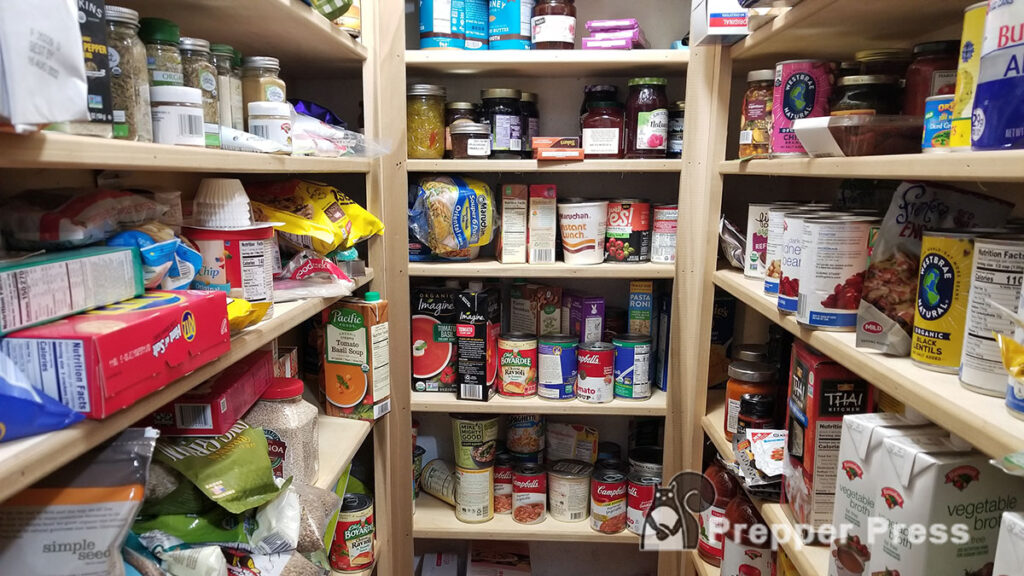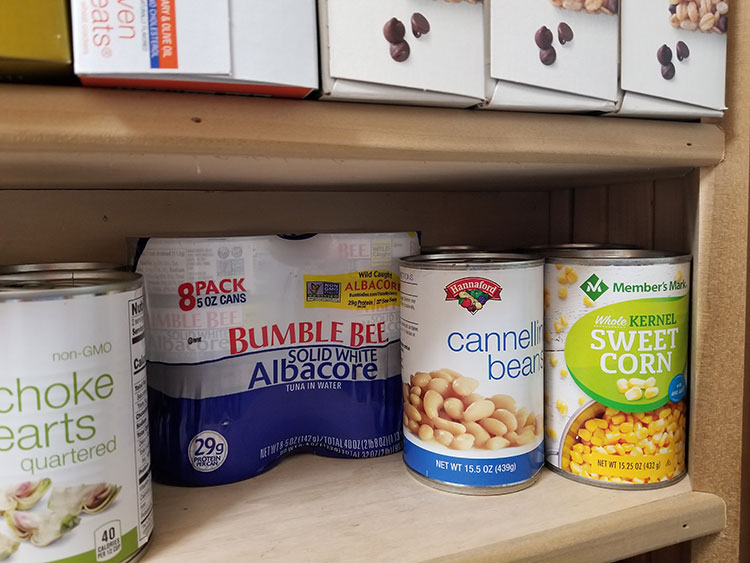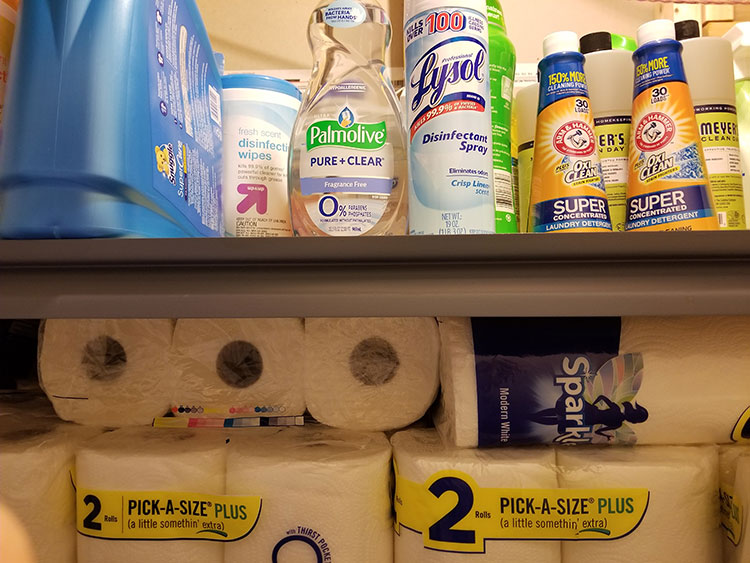
Every prepper understands the importance of a full pantry/larder, but actually achieving that goal is easier said than done. Where will you put all of the food? How much will it cost? How will you ever manage the inventory so food doesn’t go bad? Let’s break the process of building a pantry supply down into manageable steps.
with food that is both delicious and nutritious, rather than just throwing a bunch of MREs in the pantry and calling it a day. On top of that issue, we want to make sure that the food we have inside is not a jumbled mess, and that the stock is actually being rotated. So what can we do to build a quality, nutritious, and organized pantry supply?
You don’t need to concern yourself with buying the best foods for long-term storage at this point, not unless they also happen to be foods that you use on a weekly basis.
Benefits of Building a Prepper’s Pantry
Stocking a prepper’s pantry is not much different from building an everyday working pantry. In fact, from my view, it’s the same thing. The goal in building a pantry supply is to stock it full of the foods you eat on a daily or weekly basis. We are not talking about storing foods with ultra-long shelf lives here. That’s Level 2 type food preps. A prepper’s pantry is Level 1 – basic food preparations that will benefit you regardless of whether there is a crisis or not.
Those benefits to a stocked pantry include:
- Cost Savings. Groceries are expensive. Having a pantry will allow you to better buy in bulk, saving you money on a per-unit basis. American also waste insane amounts of food every year. A well-managed pantry will reduce the chances you will have to throw away old food.
- Convenience. No more last-minute trips to the grocery store for the ingredients you need for the evening’s meal. A well-run pantry will assure you have a healthy stock of the foods you use regularly.
- Prepping Confidence. Just having a stocked pantry will put you miles ahead of the average American who runs to the grocery store for every meal or just calls in delivery from Grub Hub. When well-stocked, a pantry will keep you and your family fed for weeks, if not months, in a crisis. You can rest easier knowing you have food stocked for short to mid-term emergencies.
How to Stock a Pantry
There are three mantras you want to remember when building a pantry supply:
- Stock what you eat.
- Go to your pantry for meals. Go to the grocery store for you pantry.
- Rotate stock.
Stocking what you eat is the crux of a successful food pantry. Freeze-dried foods are not something someone eats for dinner on a given night, so you are not going to store that in a pantry. In the ideal situation, you stock enough of the foods you eat every day/week to the point where you rotate through them without anything ever sitting so long it goes bad.
Having a pantry means a fundamental shift in how you view grocery shopping. Gone will be the days of “I need X for dinner Thursday night” as you make your grocery list. You will already have “X” in your pantry. Instead, you are going to make your grocery shopping list based on refilling your pantry.
Rotating stock is the hallmark of a successful pantry and eliminates food waste. You are not saving money if you have food that just sits so long it goes bad. This can happen quite easily, regardless of what you stock. You fill your pantry shelves, step back and feel proud, then 3 months later, it’s a mess and you forget what you have. In a rush to make dinner, you just grab whatever is closest, never looking at expiration dates. Last in is first out.
8 Manageable Steps to Building a Pantry Supply
Now that you have a basic understanding of what a prepper’s pantry is and how it should function, let’s break it down into manageable steps.
#1 – Invest in Proper Shelving
Most pantries will have shelving of some sort already installed when you move in, but odds are that there is room for improvement. The less wasted space that you have within your pantry, the more storage space you will have, the more organized you will be, and the less cluttered the rest of your house will look. It is much more enjoyable to have your food organized within the pantry, rather than having it haphazardly spilling out of every cabinet and drawer in the kitchen.

Food (outside of water and piles of canned goods) isn’t particularly heavy, so there is no need to invest in heavy-duty shelving like you would when buying and stacking ammo. Most shelving units you would buy at big box stores will work fine so long as they have enough shelves. You don’t need (or want) big distances between each shelf. Having more shelves with shorter distances will be better suited to storing and organizing your larder.
You can also consider investing in a door-mounted shelving system. This will improve the storage capability of your pantry and open up your other shelves. Unless your shelves butt right up against the closed pantry door, this behind-the-door space is otherwise wasted without a door-mounted shelving system.
You can also install hooks from the ceiling of your pantry. Not only does this allow you to hang bundles of herbs to dry, but baskets full of dried produce to further economize on space.
There is no one-size-fits-all solution to pantry shelving. What you inevitably end up with is going to depend on how much space you have to start with and how much food you need to store for your or your family.
#2 – Buy Common Staples First
By “common staples” I mean you should stock up on the basic bones founds in most of the recipes that you cook. Potatoes, flour, honey, sugar, rice, eggs, dried pasta, olive oil, onions, are all examples of staple ingredients that are not only versatile but have a decent shelf life as well. Odds are that you already have all the spices that you need within your spice rack. Spices combined with staple ingredients can give you everything you need to create an interesting, nourishing, and flavorful meal without feeling as if you’re eating flavored gruel.
#3 – Create Your Core Recipe List
If you have a working rotation of 25 recipes or so that you make for lunch/dinner, then you automatically know exactly what ingredients you need to keep on hand, and how much of each will last you for a month or more. This makes buying and stocking those ingredients infinitely easier beyond cutting into the dreaded “what are we going to make for dinner tonight” debate.
If I know I need 25 pounds of rice for each month, then I know I’ll need 75 pounds of rice stored if I want to be food independent for that particular ingredient for three months. A core recipe list is a way to stay organized, and the better organized you are, the easier it is to prep your food supply.
If you’re looking for more core recipes that are shelf stable to add to your repertoire, I recommend reading the following:
- Meals in a Jar by Julie Languille
- My Perfect Pantry: 150 Easy Recipes from 50 Essential Ingredients by Clarkson Potter
- Off the Shelf: Cooking from the Pantry by Donna Hay
#4 – Make Bulk Purchases Whenever Possible

Buying in bulk will save you money and time; money, because you pay less per unit; time, because you do not have to make as many trips when you buy more at once. Rice and beans, stored in food grade buckets with Gamma Seal lids are no-brainers for this type of storage.
Costco and Sam’s Club are both places where you can buy large amounts of food for a decent price. Prior to lockdown, I was able to find 10-pound boxes of dried pasta for sale at my local bargain bulk outfitter for a very decent price. Pasta can be stored for a long time. I was also able to find 25-pound bags of rice there (it’s also available online). All in all, I paid maybe $30, and walked away with almost 40 pounds of food.
#5 – Take Your Time
It is perfectly acceptable to improve your food storage incrementally. In fact, I advise it. Few of us out can afford to drop hundreds of dollars out of the blue. Though I believe there are scenarios where you truly might need to do such to protect your family (e.g. your location is about to experience a lockdown/war/riots/etc.), for the most part you can afford to prep your food storage in small steps. Develop a food plan to do such.
Commit to spending $15 per week (more if you can afford it) on stocking your larder and you’ll be surprised at how much food you are able to accumulate in just a brief period. Doing so will not only drastically improve your disaster resiliency, allow you to practice “shopping” from your food pantry, and build the habit of managing it. A working pantry will force new habits in how you approach both shopping and cooking.
#6 – Garden and Preserve
Whether you live in a rural environment or an urban one, everyone should at least try to grow something. Not only does this give you some degree of food production (even if marginal), it helps you understand the inherent difficulties that arise from attempting to grow plants.
Even if you live in an apartment there are ways to grow some of your own food. If you live somewhere where you can tend to a garden proper, then you’ll be able to produce a LOT of food. I bought Square Foot Gardening by Mel Bartholomew and followed it to a tee. His ideas work. Incorporate them into your own garden, and you’ll see. You can grow a LOT of food without needing a lot of space. Reap (and store) the harvest
#7 – Buy “Fringe” Products Last
By “fringe” products I mean make sure that you have your staples stocked, your core recipe list developed, and your other core recipe ingredients stocked before investing in products that are not as essential. SPAM, vitamins, beef jerky, freeze dried foods, and MREs are all products that I would consider fringe.
That by no means indicates that these products are useless. On the contrary, I stock them myself. But what I do mean is that I believe the staples and core recipe ingredients are going to be more commonly used, and thus more useful than the fringe.

The fringe most certainly has its perks – it’s often highly mobile – meaning you don’t have to cook it to eat it, but unless you can foresee having to go mobile such as in an escape and evasion scenario, I would focus on the staples first.
#8 – Track Your Inventory
Warning: It is easier to build a pantry supply than it is to make it a well-functioning pantry. If you do not make your pantry a functioning part of your kitchen and cooking, it will become an overcrowded mess of products that you lose track of. You forget what you have, don’t rotate stock, and end up going to buy products that you already have. You will have to get organized.
My strategy is simple – we keep a legal size clipboard hanging in the pantry. Whenever something comes out, it gets marked on the clipboard. Then, when it’s time to get groceries, that sheet comes off the clipboard and becomes an extension of the shopping list.
There are also some apps you can download to your phone or PC that will make inventorying easier:
- Alexa – “Alexa, add X to the shopping list.” Many people don’t like the privacy infringement of Amazon’s Alexa, but if you have an inexpensive Echo Dot, this will make creating a shopping list easy.
- Grocy – Grocy is a web-based “groceries and household management solution.” It is open source software with plenty of add-ons. There are also barcode scanning options. This could be the most powerful solution available. Best of all, it’s entirely free.
- MyStuff2 Pro – Another home inventory and database app, MyStuff2 Pro is for Apple products only. Beyond food, you can organize collections, books, movies, etc.
- Out of Milk – Out of Milk is the #1 most-used Android shopping list (and now available for iOs). The program has a pre-made grocery list template and offers pantry management tips and ideas. Pull something out of your pantry and then add it to Out of Milk so your shopping list is always up-to-date.
Building a Pantry Supply Summary
Creating a fully stocked pantry doesn’t have to be a daunting process. It’ll still be a process – there’s no doubt about that – but that by no means that it has to be a source of stress and frustration. By following the above advice, you’ll be able to work your way to a full and efficient larder with minimal stress.
Are there other tips or tricks that you’ve discovered to be beneficial for building a pantry supply? Is there a method you’ve found to stay organized that I didn’t cover? Let us know in the comments below!
4 comments
Hey Derrick, tons of good and practical tips here right through from what to buy to shelving, awesome!
I’ve been stocking food all year, small amount / money spent, each week and whilst I don’t notice a massive difference in my monthly spending I am accumulating a lot of food like you say.
Any tips on good prepper recipes using just store cupboard essentials / basic tinned foods?
I only found this post so far but the recipes make no sense to me considering they are things like pizza and mac and cheese neither which seem like good long life dishes or practical to make in an emergency…
https://disastershelters.net/prepper-food-recipe-ideas/
Any thoughts or resources I can check out?
Hi, Bruce. There are recipes on cooking with freeze-dried foods, but I’m not sure that’s what you’re talking about. You mention the cupboard and tinned foods. Your best bet is probably to assemble recipes specific to what’s in your cupboard. You’ll want a prepper cupboard that you eat from, rotating stock. So the recipes should be for foods you’re eating on a normal basis. These are also recipes that you can start using today. Does that help?
I’ve been planning a “How to Make a 3-Month Food Supply” article for a while. I’ll write it soon in hopes that might also help.
A “How to Make a 3-Month Food Supply” article would be awesome, what about a 6 or 12 months one too, doable?
Doable, yes, but the dynamics change quite a bit and it gets more expensive. On top of that, a 3-month supply will get you through most catastrophes without problem. Let me get through 3-month first (in addition to other articles), and then we’ll move further out.